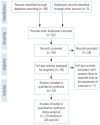Estimate of the Basic Reproduction Number for COVID-19: A Systematic Review and Meta-analysis
- PMID: 32498136
- PMCID: PMC7280807
- DOI: 10.3961/jpmph.20.076
Estimate of the Basic Reproduction Number for COVID-19: A Systematic Review and Meta-analysis
Abstract
Objectives: The outbreak of coronavirus disease 2019 (COVID-19) is one of the main public health challenges currently facing the world. Because of its high transmissibility, COVID-19 has already caused extensive morbidity and mortality in many countries throughout the world. An accurate estimation of the basic reproduction number (R0) of COVID-19 would be beneficial for prevention programs. In light of discrepancies in original research on this issue, this systematic review and meta-analysis aimed to estimate the pooled R0 for COVID-19 in the current outbreak.
Methods: International databases (including Google Scholar, Science Direct, PubMed, and Scopus) were searched to identify studies conducted regarding the R0 of COVID-19. Articles were searched using the following keywords: "COVID-19" and "basic reproduction number" or "R0." The heterogeneity among studies was assessed using the I2 index, the Cochran Q test, and T2. A random-effects model was used to estimate R0 in this study.
Results: The mean reported R0 in the identified articles was 3.38±1.40, with a range of 1.90 to 6.49. According to the results of the random-effects model, the pooled R0 for COVID-19 was estimated as 3.32 (95% confidence interval, 2.81 to 3.82). According to the results of the meta-regression analysis, the type of model used to estimate R0 did not have a significant effect on heterogeneity among studies (p=0.81).
Conclusions: Considering the estimated R0 for COVID-19, reducing the number of contacts within the population is a necessary step to control the epidemic. The estimated overall R0 was higher than the World Health Organization estimate.
Keywords: Basic reproduction number; COVID-19; Meta-analysis; Outbreak; Public health.
Conflict of interest statement
The authors have no conflicts of interest associated with the material presented in this paper.
Figures



References
Publication types
MeSH terms
LinkOut - more resources
Full Text Sources

